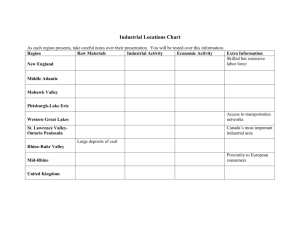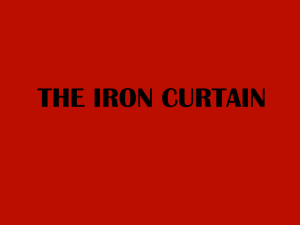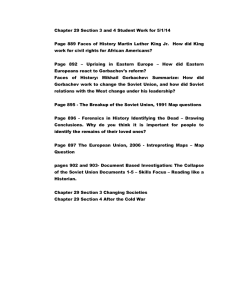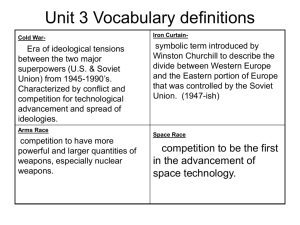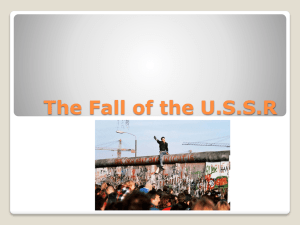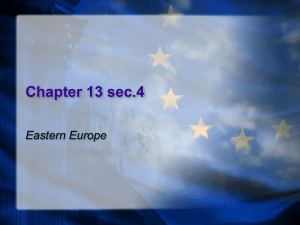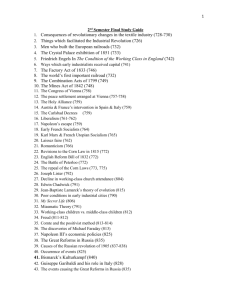Geopolitische Rahmenbedingungen
advertisement
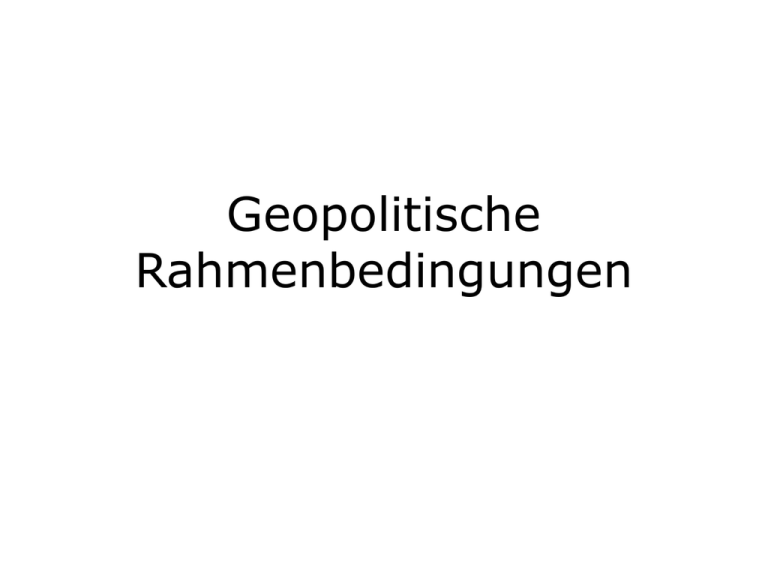
Geopolitische Rahmenbedingungen Contents 1. Military over-extension 2. Consequences of political change 3. The economic costs of the Eastern Bloc Military over-extension • “the power of states may be indexed by the expansion, contraction, or stability of state boundaries over long periods of time. This powers depends on the ability of a government to concentrate more military forces at any point within these boundaries than any rival can bring to bear” RANDALL COLLINS The Future Decline of the Russian Empire. Weberian Sociological Theory, Cambridge: CUP, p. 186 Military over-extension • „Marchland“ and „interior“ States • A “marchland” state is surrounded by mountains, plains or water in more than one direction. It is therefore less vulnerable to attacks. • An “interior” state faces militarily capable states more than one side. It is therefore more vulnerable to attacks. Collins 1986: 187-8 • Russia went from a “marchland” state to an “interior” state during its historic expansion. Collins 1986: 195 Military over-extension • Sino-Soviet Split • Mao and Kruschev have different ideas about the future direction of world communism. • In late 1960‘s the Soviets positioned troops, heavy artillery and missiles on the Chinese border. Actual fighting breaks out twice in 1969. • The Soviet Union even broadcast radio messages into China warning of the nuclear capability. LORENZ M. LÜTHI (2008), The Sino-Soviet Split, Princeton: Princeton University Press, p. 340-1 • “the degree of over-extension that exists on several fronts has kept the Soviet military budget extremely high even in peace time.” Collins 1986: 200 Military over-extension • Ethnic Nationalism • Problems increase when trying to maintain control of ethnicities that are separated from the dominating power by another ethnic group. Collins 1986: 200 Military over-extension From Columbia University: http://www.columbia.edu/itc/mealac/pritchett/00maplinks/overview/ethnicmaps/centralasia _ethnic_PC.jpg Military over-extension • The Afghanistan War 1. • Perception Effects leaders perceived less favourably the usefulness military intervention. Despite punishments, many soldiers avoided service. 2. • Military Effects Conditions in Afghanistan and the lack of housing and adequate medical care on their return cause many returning soldiers (Afghantsty) to join protest movements and groups. 3. • Legitimacy Effects War perceived by many non-Russians as a “Russian War being fought by nonRussians.” Some leaders in Central Asia speak out against the war and are replaced by Russians, thus causing violent protests. • 4. • Glasnost Effects Increasingly independent reporting of events by the press throughout the 1980‘s. RAFAEL REUVENY and ASEEM PRAKASH (1999). The Afghanistan war and the breakdown of the Soviet Union. Review of International Studies, 25, p.694 Military over-extension • Conclusion • “The activation of military crises in any area opens up vulnerabilities in other areas.” Collins 1986: 201 • “[the situation in Poland] fits logically with a situation in which the Russians are hesitant to intervene because of expensive commitments in Afghanistan” Collins 1986: 201-2 Consequences of political change • The Perfect Empire • Colonies should provide a reliable ally by contributing to the defence burden and enhancing empires power in the international system • Colonies should be cheap to administer but increase economic stability • Finally they should be seen by the domestic population as an asset VALERIE BUNCE (1985), The Empire Strikes Back: The Evolution of the Eastern Bloc from a Soviet Asset to a Soviet Liability. International Organization, Vol. 39, No. 1, p. 3. Consequences of political change • Stalin’s control over the colonies • The Soviet Union had gained control in these countries, through socalled liberation. • The Soviet Union had the largest role in the creation of the communist parties in Eastern Europe. • The Soviet Union demonstrated in 1948 that it was in control of the leadership selection, and it preferred Moscow-trained communists • The Soviet Union was the hegemon because it had succeeded in isolating the area which it dominated from the international system. Bunce 1985: 6 Consequences of political change Eastern Europe‘s remaining an asset to the Soviet Empire depended on four pre-conditions: 1. Rapid economic growth in the client states 2. Continued Soviet control over world communism 3. Continued abilities of Eastern European parties to maintain their control 4. Continuing congruence between the political interests of the Soviet and East European elites Bunce 1985: 8-9 Consequences of political change • De-Stalinisation • The end of the personality cult and one man rule • The of random mass terror. • Reconciliation with Josip Tito. • The acknowledgement of crime committed under Stalinism. NORMAN DAVIES (1996), Europe: A History, London: Pimlico, p. 1091. Consequences of political change • Consequences of de-Stalinisation • The criticism of Stalin and reconciliation with Tito undermined the authority of many elites. • Loosening of authoritarian controls leads to increased demands for further reforms Consequences of political change • Hungary 1953-56 • 1953: Imre Nagy was installed as Prime Minister, and was told to pursue a new course. Among the reforms were to be reduce the brutality of the secret police (ÁHV) • 1955: Nagy‘s reforms went too far and were seen as a threat to Soviet ideals. He was replaced by hardliner Hegedűs. • 1956: In June in Poznań, Poland a mass strike takes place. Emboldening those in Hungary angry at Nagy’s replacement. CHARLES GATI (2008), Failed Illusions: Moscow, Washington, Budapest and the 1956 Hungarian Revolt, Chicago: Stanford University Press, p. 24-5 Consequences of political change • Hungary 1956 • Protesters were not pro-democracy but nationalists who aimed to imitate Tito’s model of a nationalist form of socialism. • The Soviets were pushed out, however when Nagy stated Hungary’s intention to leave the Warsaw Pact. Gati 2008: 3 Consequences of political change • Conclusion • Loosening of constraints on society caused increasing demands from below. • Aspects of de-Stalinisation undermined many regimes and led to social upheaval. • Such protest movements as those in Hungary, before that in the DDR (1953), Poznań (1956) and then later in Prague (1968), took an economic, political and military toll on the Soviet Union, because of its monopoly on resources in all of these areas. Economic costs of the Eastern Bloc Eastern Europe‘s remaining an asset to the Soviet Empire depended on four pre-conditions: 1. Rapid economic growth in the client states 2. Continued Soviet control over world communism 3. Continued abilities of Eastern European parties to maintain their control 4. Continuing congruence between the political interests of the Soviet and East European elites Bunce 1985: 8-9 Economic costs of the Eastern Bloc Maintenance of power in Stalinist society Political power Strong economic perfomance Control of economic resources High investment and low consumption Economic costs of the Eastern Bloc • Consequences of de-Stalinisation • East European leaders aware of their strategic importance to the Soviet Union demanded help from Moscow in order to ensure stability. • The Soviet Union began to subsidise products and materials traded with the Eastern Bloc. Therefore increasing consumption. This policy continued throughout the 1960’s. Bunce 1985: 12 Economic costs of the Eastern Bloc • Economic slow-down • Soviet growth hit post-war low of 5% between 1961 and 1965. This is caused by: • Costs of having extended aid programs to regimes in trouble • Eastern Europe was unable to produce products that the Soviet Union needed, nor the quality that it required. Bunce 1985: 15 Economic costs of the Eastern Bloc • Brezhnev’s economic initiatives • Clients states were encouraged to implement more economic plans. • Client states pressured to specialise, so that the north would focus on production of consumer goods and machine tools and the south on raw materials and agriculture. • To encourage quality improvements and take some of the pressure of the Soviet Union, trade conditions with the west were improved and Eastern Europe was able to trade in world markets. Bunce 1985: 15 Economic costs of the Eastern Bloc • Consequences of Brezhnev’s initiatives • Specialisation helped to ensure that the countries of Eastern Europe were too inflexible for the turbulence of world markets • Eastern European states were unable to keep up with market prices, therefore running up a trade deficit. • The technology they needed in order to raise productivity was unavailable in the Bloc. • The raw materials and other goods that the Soviet Union were producing were desired in the world markets, however they had to supply these goods at artificially low prices to their client states. Bunce 1985: 33 Economic costs of the Eastern Bloc Estimated implicit Soviet trade subsidies to Eastern Europe (in million (1982) US dollars) 8000 7000 6000 5000 4000 3000 2000 1000 0 1974 1975 1976 1977 1978 1979 1980 From: Vanous and Marrese 1982, quoted in Bunce (1986) p.15 Bulgaria Czech. DDR Hungary Poland Romania Economic costs of the Eastern Bloc Soviet Trade with the West 60 50 40 Imports (billion US$ 1982 value) 30 Exports (billion US$, 1982 value) 20 10 Bunce 1985: 36 19 81 19 80 19 79 19 78 19 77 19 73 19 71 0 Economic costs of the Eastern Bloc C on ia d Un i ie t So v R om an la n Po un g ar y R H ak lo v os ze ch Bu lg a Bunce 1985: 43 G D ia 450 400 350 300 250 200 150 100 50 0 ria % Total Western Debt by End Year 1980 as Percentage of Hard Currency Export earnings Economic costs of the Eastern Bloc The ratio of payments (interest and principal due) to exports of goods and services earnings in Western interaction 120 100 % 80 Poland 60 Soviet Union 40 20 0 1970 Bunce 1985: 40 1977 1980 Economic costs of the Eastern Bloc • Polish Crisis • Edward Gierek replaced Wladyslaw Gomulka in 1970, promising to build a new Poland based on consultation and communication, involving a degree of freedom of speech, and with a modern economy. • Western credit would be used to buy western technology. • These reforms were initially very successful. HELENE SJURSEN (2003), The United States, Western Europe and the Polish Crisis: International Relations in the Second Cold War, Basingstoke: MacMillan, p. 22 Economic costs of the Eastern Bloc • Polish Crisis • 1973 Oil crisis meant that markets for Polish products dried up. • However, Poland still required Western products and thus more credits. • Gierek kept food prices at 1970 level until 1976, when he raised average food prices by 60%, provoking protests. • Under pressure Gierek back-tracked and lowered the prices again. Sjursen 2003: 22 Economic costs of the Eastern Bloc • Polish Crisis • 1979 global recession made the economic situation for Poland even worse. Gierek was forced to raise food and energy prices again. • on 14th of August 1980 the Inter-Factory Strike Committee was setup, and various demands were made of the government, including freedom of speech, right to strike and the release of political prisoners. • The government gave in to almost all of the demands so that on the 31st August the Gdansk agreement was signed. • In the following month Gierek was ousted. Sjursen 2003: 28 Economic costs of the Eastern Bloc • Polish Crisis • Solidarity trade union came into being in 1981 following Gdansk Agreement. • In 1982 martial law was declared and Solidarity outlawed due to the threat of invasion by the Soviets and there was a brutal repression of its members. • The mid-1980’s were characterised by massive shortages in food, housing and energy which fuelled bitterness against the regime. • With the introduction of Glasnost and Perestroika the threat of invasion disappeared. Talks between Solidarity and the government took place. The result was semi-free elections which ended in humiliation for the government. Economic costs of the Eastern Bloc Maintenance of power in Stalinist society Political power Strong economic perfomance Control of economic resources High investment and low consumption Economic costs of the Eastern Bloc Political power threatened due to high prices and worsened working conditions Weak economic Perfomance caused by inflexibility Control of economic weakened as debts need to be paid High consumption allowed in order to prevent dissent CONCLUSIONS • From the death of Stalin until its eventual collapse, the Soviet Union was being increasingly stretched. It’s huge size and powerful enemies meant it was economically and militarily costly to defend it’s borders. The increasing political and economic weakness of the Eastern Bloc was a drain on Soviet resources and played a huge role in its eventual collapse.
